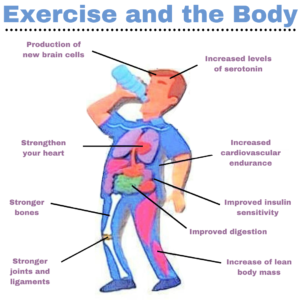
Building a Pandemic-Friendly Fitness Routine
Why it’s important, how to start, and social benefits
Lisa Balestrino MS, RD, LDN, CPT
Sitting is the new smoking. Yes, you read that right. Research has shown that as the proportion of our day spent sitting goes up, so does our risk for developing conditions such as cancer, type 2 diabetes, insulin resistance, cardiovascular disease, back pain, depression, and anxiety.
According to the American Heart Association, the percentage of sedentary jobs in the United States has increased by 83% since 1950, and that prior to the COVID-19 outbreak, Americans were already spending more than half of their days sitting (up to 15 hours for some office workers)!– a number which has more than likely gone up as 2020 has progressed. These days, a greater percentage of us are now working from home, we’re relying on delivery services rather than shopping in stores, and public recreational facilities such as parks and gyms have only recently started to reopen, leading to an even more sedentary lifestyle.
And while most of us have adapted to this “new normal,” it seems we are only recently starting the discussion on what this means in terms of physical and mental health. Our practice’s approach to nutrition and health management is holistic and goes way beyond the way we eat. We focus on physical fitness and emotional health outcomes too. When I discuss exercise with my patients I tend to hear one of two things:
- More time at home has meant more time for a regular exercise routine, or to start working on their physical fitness for the first time ever (amazing)
- Exercise stopped when the world “stopped” and has not found its way back into their lives since (totally understandable, but also less amazing)
Either way, this often prompts further discussion in terms of A) how adaptations to their “regular” fitness routine have had to occur or B) what barriers have stood in the way of adapting to a new COVID-friendly and sustainable exercise regimen.
For those of us in the latter category, or who are starting to think about what maintaining a physical activity regimen is going to look like long-term, let’s talk logistics. No matter how much we’d like to deny it, COVID-19 is likely sticking around for the foreseeable future. Therefore, in the same way, that we’ve grown to accept our current day-to-day lives as the new normal, we need to start thinking about a new normal fitness routine- because just as wearing a mask when in public has become non-negotiable, some degree of movement in our day should be non-negotiable as well. So where do we start? Let’s define what “exercise” is first…
What Do We Mean When We Say “Exercise” and What are the General Recommendations?
The definition of exercise or physical activity as defined by the World Health Organization is “any bodily movement produced by skeletal muscles that require energy expenditure.” By my personal and professional definition, exercise is a celebration of what our bodies are capable of doing, where pushing one’s limits of strength, endurance or flexibility is an expression of self-love, rather than something that is done as a punishment.
The CDC exercise recommendations for adults is to perform 150 minutes (2 hours and 30 minutes) to 300 minutes (5 hours) a week of moderate-intensity, OR 75 minutes (1 hour and 15 minutes) to 150 minutes (2 hours and 30 minutes) a week of vigorous-intensity aerobic physical activity. In addition, strength training activities of moderate or greater intensity, and that involve all major muscle groups, should be performed 2 or more days per week – as these will provide added health benefits such as increased metabolic rate, improved posture, increased joint stability, and better flexibility.
Tying the two together, we’re aiming for 150 minutes a week – or more – of whatever type of movement you choose (and enjoy!), ideally with some resistance-style movements thrown in, keeping in mind that bodyweight exercises like push-ups, air squats, or step-ups count as resistance training too.
What Happens to Our Bodies When We Exercise?
Similarly to our dietary intake, physical activity has the ability to impact and support all of our bodies’ systems. Some beneficial effects of regular exercise include:
- A decrease in inflammation and inflammatory markers like c-reactive protein
- Strengthening of the heart (it’s a muscle too!) and reduction in blood pressure
- Increased cardiovascular endurance and muscular strength
- Increase in lean body mass, and therefore the number of mitochondria- the powerhouse of the cell and driver for increasing metabolic rate
- Stronger bones, ligaments, and joints
- Increased levels of the neurotransmitter serotonin – responsible for regulating sleep, body temperature, mood, appetite, digestion, and other biological rhythms – with a simultaneous reduction in cortisol levels in the long term, making us feel happier, less stressed, and have fewer food cravings
- Improved insulin sensitivity, which reduces the risk of chronic diseases like obesity, cardiovascular disease, diabetes, and PCOS
- Increased energy levels
- Production of new brain cells, also known as neurogenesis
Social Benefits of Exercise
Not only does exercise provide enormous benefits in terms of our physical health, but it also does wonders to improve other dimensions of personal health or overall “wellness” such as social and emotional health. This year more than ever, people around the world have reported feeling isolated, lonely, and disconnected from their communities which contributes significantly to the overall quality of life. By finding a way to get involved in a group-orientated exercise program either in-person (six feet apart of course!) or virtually, you can improve motivation to exercise, build confidence, create discipline, build friendships and create a new sense of community.
How do I start?
Here are some tips on how to make exercise a habit you can stick to.
- Set a SMART goal! Smart goals are Specific, Measurable, Attainable, Realistic, and Time-Bound. For someone who wants to start walking, a goal could look like this: I will walk for 20 minutes, 2 days per week before work for 8 weeks, starting on Monday. Notice this is also helping us build a habit, as the duration is set for a long enough to build a solid foundation, and also the time spent and frequency of activity is not setting us up for failure by being unrealistic. I always encourage my patients to start small- every little bit counts!
- Schedule it into the week. Just as we set time aside for taking kids to soccer practice, cooking dinner, and going to work, we can, and should, pre-plan physical activity into our day/week. If setting aside 30 minutes out of a day feels unrealistic, try breaking it up into 5-10 minute intervals throughout the day. Any movement is better than zero movement.
- Try new and different things! Never tried Pilates before? Many facilities offer your first class free, and are offering virtual classes! Been curious about that local outdoor Bootcamp? Give it a go. The point is, you never know what you might enjoy until you try. And think outside the “big box gym” box. You don’t have to have a gym membership to get fit.
- Need a free option or not sure how to build your own workout plan? Check these out:

And remember, the type of exercise that’s right for you is the one you enjoy, and stick with!
Get the help you need to start a plan for exercise, and to support your nutrition goals
We are here to help you and our office is open for Telehealth visits, both for existing patients and new patients. What you choose to eat is an essential contributor to your health and also supports a healthy lifestyle in conjunction with regular physical activity.
Click here to contact us for more information. Most major health insurance companies are covering Telehealth visits, usually at no cost to you. Our office will verify your benefits for you.
If you enjoyed and benefited from this information, please like and share it.
Lisa Balestrino MS, RD, LDN, CPT
Illustration by Ashley Henley
Categories
Call Us Today: 919-990-1130






